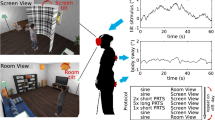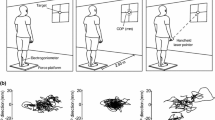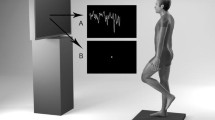Abstract
Seventy-nine young, healthy adults were led through static balance and weight-shifting activities in order to study the effects of visual feedback on balance. Based on their performance, the relative effects of various feedback properties were analyzed: (1) arrangement [direct center of pressure (CoP) vs. lateral weight distribution feedback], (2) numbers (presence vs. absence of numeric feedback), and (3) dimensionality (1D vs. 2D CoP information). In the static balance activity, subjects were instructed to maintain equal weight across both feet; in the dynamic weight-shifting activity, subjects were instructed to shift their weight to each displayed target location. For static balance, lateral symmetry and sway were measured by classical parameters using CoP, center of gravity (CoG), and the difference between the two (CoP–CoG). Weight-shifting balance performance was measured using the time required to shift between target CoP positions. Results indicated that feedback arrangement had a significant effect on static sway and dynamic weight shifting, with direct CoP feedback resulting in better balance performance than lateral weight distribution. Also, numbers had a significant effect on static sway, reducing lateral sway compared to feedback without numbers. Finally, 2D CoP feedback resulted in faster performance than 1D CoP feedback in dynamic weight shifting. These results show that altering different properties of visual feedback can have significant effects on resulting balance performance; therefore, proper selection of visual feedback strategy needs to take these effects into consideration.




Similar content being viewed by others
References
Baquis GD, Pessin MS, Scott RM (1985) Limb shaking-a carotid TIA. Stroke 16(3):444–448. doi:10.1161/01.STR.16.3.444
Boudrahem S, Rougier PR (2009) Relation between postural control assessment with eyes open and centre of pressure visual feedback effects in healthy individuals. Exp Brain Res 195(1):145–152. doi:10.1007/s00221-009-1761-1
Cheng PT, Wang CM, Chung CY, Chen CL (2004) Effects of visual feedback rhythmic weight-shift training on hemiplegic stroke patients. Clinical Rehabil 18(7):747–753. doi:10.1191/0269215504cr778oa
Clark RA, Bryant AL, Pua Y, McCrory P, Bennell K, Hunt M (2010) Validity and reliability of the Nintendo Wii Balance Board for assessment of standing balance. Gait and Posture 31(3):307–310. doi:10.1016/j.gaitpost.2009.11.012
Dault MC, de Haart M, Geurts ACH, Arts IM, Nienhuis B (2003) Effects of visual center of pressure feedback on postural control in young and elderly healthy adults and in stroke patients. Hum Mov Sci 22(3):221–236. doi:10.1016/S0167-9457(03)00034-4
de Haart M, Geurts ACH, Dault MC (2005) Restoration of weight-shifting capacity in patients with postacute stroke: a rehabilitation cohort study. Arch Phys Med Rehabil 86(4):755–762. doi:10.1016/j.apmr.2004.10.010
Geiger RA, Keefe JO, Hicks RR (2001) Balance and mobility following stroke: effects of physical therapy biofeedback/forceplate training. Phys Ther 81(4):995–1005
Geurts ACH, De Haart M, Van Nes IJW, Duysens J (2005) A review of standing balance recovery from stroke. Gait and Posture 22(3):267–281. doi:10.1016/j.gaitpost.2004.10.002
Gil-Gómez JA, Lloréns R, Alcañiz M, Colomer C (2011) Effectiveness of a Wii balance board-based system (eBaViR) for balance rehabilitation: a pilot randomized clinical trial in patients with acquired brain injury. J Neuroeng Rehabil 8:30. doi:10.1186/1743-0003-8-30
Hamm RJ, Dixon CE, Gbadebo DM, Singha AK, Jenkins LW, Lyeth BG, Hayes RL (1992) Cognitive deficits following traumatic brain injury produced by controlled cortical impact. J Neurotrauma 9(1):11–20. doi:10.1089/neu.1992.9.11
Hocking RR (1976) The Analysis and Selection of Variables in Linear Regression. Biometrics 32(1):1–49. doi:10.2307/2529336
Kennedy MW, Schmiedeler JP, Striegel AD, Crowell CR, Villano M, Kuitse J (2011) Enhanced feedback in balance rehabilitation using the Nintendo Wii Balance Board. 13th International Conference on E-Health Networking, Application and Services. doi:10.1109/HEALTH.2011.6026735
Parmar PN, Huang FC, Patton JL (2011) Simultaneous coordinate representations are influenced by visual feedback in a motor learning task. 33rd Annual International Conference of the IEEE EMBS. doi:10.1109/IEMBS.2011.6091668
Patton JL, Lee WA, Pai Y-C (2000) Relative stability improves with experience in a dynamic standing task. Exp Brain Res 135(1):117–126. doi:10.1007/s002210000500
Raymakers JA, Samson MM, Verhaar HJJ (2005) The assessment of body sway and the choice of the stability parameter(s). Gait and Posture 21(1):48–58. doi:10.1016/j.gaitpost.2003.11.006
Rougier PR (2004) Optimising the visual feedback technique for improving upright stance maintenance by delaying its display: behavioural effects on healthy adults. Gait and Posture 19(2):154–163. doi:10.1016/S0966-6362(03)00056-0
Rougier PR (2005) Compatibility of postural behavior induced by two aspects of visual feedback: time delay and scale display. Exp Brain Res 165(2):193–202. doi:10.1007/s00221-005-2288-8
Rougier PR (2009) Undisturbed stance control in healthy adults is achieved differently along anteroposterior and mediolateral axes: evidence from visual feedback of various signals from center of pressure trajectories. J Mot Behav 41(3):197–206. doi:10.3200/JMBR.41.3.197-206
Rougier PR, Boudrahem S (2010) Effects of visual feedback of center-of-pressure displacements on undisturbed upright postural control of hemiparetic stroke patients. Restorative Neurology and Neuroscience 28(6):749–759. doi:10.3233/RNN-2010-0544
Rougier PR, Caron O (2000) Center of gravity motions and ankle joint stiffness control in upright undisturbed stance modeled through a fractional Brownian motion framework. J Mot Behav 32(4):405–413. doi:10.1080/00222890009601390
Rougier PR, Farenc I, Berger L (2004) Modifying the gain of the visual feedback affects undisturbed upright stance control. Clin Biomech 19(8):858–867. doi:10.1016/j.clinbiomech.2004.04.013
Rowe F, Brand D, Jackson CA et al (2009) Visual impairment following stroke: do stroke patients require vision assessment? Age Ageing 38(2):188–193. doi:10.1093/ageing/afn230
Sackley CM, Lincoln NB (1997) Single blind randomized controlled trial of visual feedback after stroke: effects on stance symmetry and function. Disabil Rehabil 19(12):536–546. doi:10.3109/09638289709166047
Stanton R, Ada L (2011) Biofeedback improves activities of the lower limb after stroke: a systematic review. J Physiother 57:145–155. doi:10.1016/S1836-9553(11)70035-2
Steadman J, Donaldson N, Kalra L (2003) A randomized controlled trial of an enhanced balance training program to improve mobility and reduce falls in elderly patients. J Am Geriatr Soc 51(6):847–852. doi:10.1046/j.1365-2389.2003.51268.x
Tatemichi TK, Desmond DW, Stern Y, Paik M, Sano M, Bagiella E (1994) Cognitive impairment after stroke: frequency, patterns, and relationship to functional abilities. J Neurol Neurosurg Psychiatr 57(2):202–207. doi:10.1136/jnnp.57.2.202
Van Peppen RPS, Kortsmit M, Lindeman E, Kwakkel G (2006) Effects of visual feedback therapy on postural control in bilateral standing after stroke: a systematic review. J Rehabil Med 38(1):3–9. doi:10.1080/16501970500344902
Walker C, Brouwer BJ, Culham EG (2000) Use of visual feedback in retraining balance following acute stroke. Phys Ther 80(9):886–895
Winstein C, Gardner E, McNeal D, Barto P, Nicholson D (1989) Standing balance training: effect on balance and locomotion in hemiparetic adults. Arch Phys Med Rehabil 70(10):755–762
Winter DA, Patla AE, Prince F, Ishac M, Gielo-Perczak K (1998) Stiffness control of balance in quiet standing. J Neurophysiol 80:1211–1221. doi:10.1016/S0966-6362(97)83378-4
Young W, Ferguson S, Brault S, Craig C (2011) Assessing and training standing balance in older adults: a novel approach using the “Nintendo Wii” Balance Board. Gait and Posture 33(2):303–305. doi:10.1016/j.gaitpost.2010.10.089
Zijlstra A, Mancini M, Chiari L, Zijlstra W (2010) Biofeedback for training balance and mobility tasks in older populations: a systematic review. J Neuroeng Rehabil 7(1):58. doi:10.1186/1743-0003-7-58
Acknowledgments
This material is based upon work supported by the National Science Foundation under grant no. IIS-1117706. Many thanks to Leilani Aldridge, Austin Atherton, Kathryn Elliot, Angela Ferreira, Allison Jeter, Brittany Jones, Mitchell Kajzer, Francis Kamen, Kalyn McGinnis, Brendan O’Shea, Jamie Segerson, Stephanie Sonnick, Gerald Wilson, and Julaine Zenk for their assistance with data collection. Thanks also to Professor Fang Liu from the University of Notre Dame’s Department of Applied and Computational Mathematics and Statistics for providing statistical consultation on the analysis of the study data.
Author information
Authors and Affiliations
Corresponding author
Rights and permissions
About this article
Cite this article
Kennedy, M.W., Crowell, C.R., Striegel, A.D. et al. Relative efficacy of various strategies for visual feedback in standing balance activities. Exp Brain Res 230, 117–125 (2013). https://doi.org/10.1007/s00221-013-3634-x
Received:
Accepted:
Published:
Issue Date:
DOI: https://doi.org/10.1007/s00221-013-3634-x




